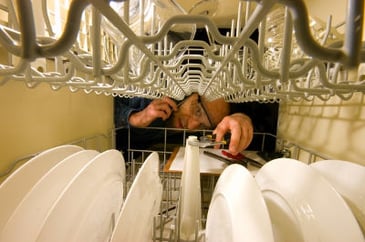 Have you ever put a new dish in your dishwasher, only to find it misshapen and mangled when you pull it out?
Have you ever put a new dish in your dishwasher, only to find it misshapen and mangled when you pull it out?
Since the dishwasher became a common household appliance during the 20th century, dishwasher testing for kitchenware has become an important on-site test during product inspection. Modern dishwashers save more water and are more hygienic than traditional hand washing, since they're able to run with water at a higher temperature than what is achievable with handwashing.
But exposure to high temperature water and high-pressure jets over an extended period of time has forced cookware manufacturers to adapt. With these changes to manufacturing cookware products, the popular claim that a product is “dishwasher safe” has become a selling point.
Product inspections performed at factories to verify quality also typically include dishwasher testing for kitchenware to verify this claim. And any cookware that claims to be dishwasher safe is subject to extensive testing to ensure it won’t be damaged after repeated washing in a machine.
Whether you are using ceramic, stainless steel, silicone or Pyrex polymer kitchenware, any item that claims to be dishwasher safe should go through the same method of testing during a product inspection before the goods leave the factory. Here you'll learn everything you need to know about dishwasher testing for kitchenware.
What type of kitchenware should be dishwasher tested?
Not every product in your kitchen can be dishwasher safe. Some materials are just not meant or able to withstand the abuse of being washed in a dishwasher. The most common known materials to avoid when it comes to dishwasher testing are cast iron, wood and more delicate materials like China or crystal. However, those are usually not products used on a daily basis, and the dishwasher is made to accommodate daily use specifically. The items you should be looking out for to put through QC testing are:
- Basic ceramics such as plates, bowls and mugs
- Stainless steel
- Stoneware
- Hard plastics
- Silicone and metal kitchen utensils
- Porcelain
These materials make up some of the most commonly used items in everyday households and are the most prone to heavy dishwasher use. As a consumer or importer, you should make sure your products have been put through dishwasher testing before buying.
Is testing necessary?
As the technology in dishwashers evolves, testing for cookware has to progress along with it in order to keep up. The extreme conditions inside a dishwasher are the cause of the all-too-common warping and distortion seen after placing a product that was not dishwasher safe through a cycle.
"Not only is on-site testing performed to protect the product but to look after the consumer as well."These days products are being coated with all kinds of chemicals in order to make them non-stick or easier to wash. Those chemicals can seep into your food if they are not applied correctly. And a dishwasher test can reveal this potential issue after a couple of cycles.
5 Steps to Dishwasher Testing for Kitchenware
Testing for your cookware is very simple and straightforward. It only involves going through one to five cycles, depending on the type of product and manufacturer. But there are several of signs inspectors have to look for after conducting each cycle.
1. Examine the sample
First, the item is carefully examined before testing to make sure there is no pre-existing structural damage to your product.
 2. Run the item through a cycle in the dishwasher
2. Run the item through a cycle in the dishwasher
Your item being tested is then placed inside the dishwasher and put through the first cycle with regular detergent, including a drying cycle.
3. Re-inspect the item
Immediately after, your item is inspected to verify that the heat in the dishwasher has not caused chipping or cracks.
4. Run the item through additional cycles
It is common for an object to go through more than one cycle, especially if it has a glossy coating. This is to spot any fading in shine or discoloration indicating the item was not coated correctly.
At no point during inspection should there be any deterioration or noticeable changes to the item.
Conclusion
Dishwasher testing for kitchenware products is essential to protecting the customer from false claims that products are dishwasher safe. In order to guarantee true product quality and protect the your safety, a dishwasher test can make sure your product withstands the daily wear and tear in a modern kitchen.
"Dishwasher testing is essential to protecting the customer from false claims that products are dishwasher safe."As a buyer of kitchenware products, you’ll want to be sure that any claims to product quality and safety are tested during product inspection. Prudence before the goods leave the factory will pay dividends in fewer returns and positive customer reviews!
Do you have other tips to shared for dishwasher testing? Share in the comments below!







